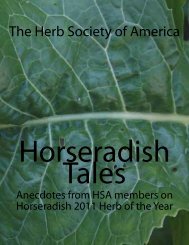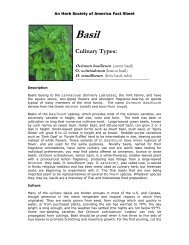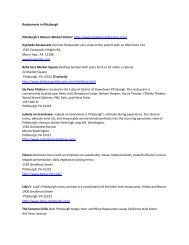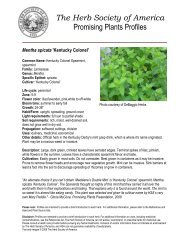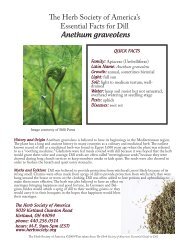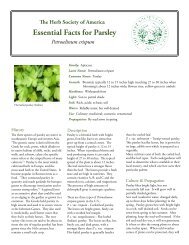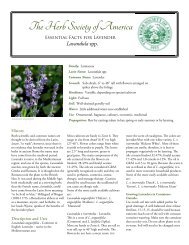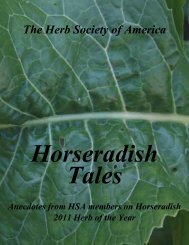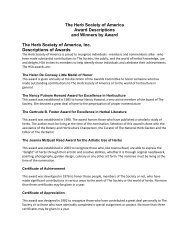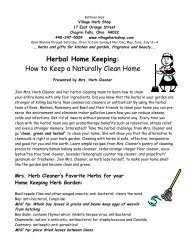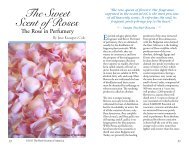The Beginner´s Herb Garden - The Herb Society of America
The Beginner´s Herb Garden - The Herb Society of America
The Beginner´s Herb Garden - The Herb Society of America
You also want an ePaper? Increase the reach of your titles
YUMPU automatically turns print PDFs into web optimized ePapers that Google loves.
<strong>Garden</strong> Site<br />
Choose an area for growing herbs on which the sun shines<br />
four to six hours or more per day. <strong>The</strong> afternoon sun is<br />
strongest and is preferable in northern climates. In the<br />
South, herbs benefit from some shade in the afternoon.<br />
However, if you have a shady yard there are a number <strong>of</strong><br />
herbs that will do well for you. (See the <strong>Herb</strong>s for Shade list.)<br />
<strong>The</strong> site must be well drained. If water remains on top <strong>of</strong> the<br />
soil, drainage is poor and herb growth will be unsatisfactory.<br />
If a badly drained site is the only one available, tiling may<br />
be installed, or, less expensively, raised beds may be<br />
constructed. Raised beds can be built with extra soil kept in<br />
place by raised bed<br />
edgings <strong>of</strong> brick, stone or landscape timbers. A mounded<br />
bed does not require an edging at all, however, this look is<br />
more appropriate in an informal plan. Adding a great deal <strong>of</strong><br />
organic matter to the top two feet <strong>of</strong> soil can also improve<br />
drainage in heavy clay soils.<br />
Choice <strong>of</strong> Plants<br />
Although an herb may be a tree, shrub, vine, or bulb, most<br />
herbs are herbaceous (non-woody) in character. Some<br />
herbs, such as lavender, rosemary and hyssop, may become<br />
semi-shrubs with woody stems, especially in temperate<br />
zones.<br />
Like other plants, herbs classified as annuals have but one<br />
season <strong>of</strong> growth, though some <strong>of</strong> them reseed. Biennials<br />
have two seasons <strong>of</strong> growth, producing leaves the first<br />
year and flowering and setting seed the second year. Most<br />
biennials will reseed themselves, so by planting them two<br />
years consecutively, you should have some plants producing<br />
leaves for harvest and others flowering and reseeding<br />
12 ©2010 <strong>The</strong> <strong>Herb</strong> <strong>Society</strong> <strong>of</strong> <strong>America</strong>




